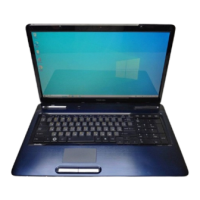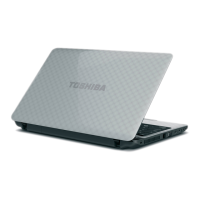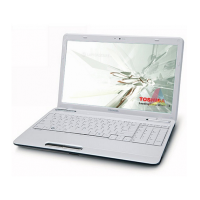
Do you have a question about the Toshiba Satellite L775D and is the answer not in the manual?
Describes the formats used in the manual for terms and procedures.
Explains the use of abbreviations and acronyms within the manual.
Identifies icons used to represent computer parts and functions.
Ensures proper airflow around the computer and AC adapter to prevent overheating.
Recommends a suitable work area, protecting the computer from environmental factors.
Lists essential hardware, documentation, and software included with the computer.
Provides step-by-step instructions for connecting the AC power adapter.
Details how to properly open the computer's display panel.
Explains the procedure for powering on the computer for the first time.
Describes the methods for shutting down the computer (Shut Down, Sleep, Hibernation).
Explains how to use Sleep Mode to interrupt and resume work efficiently.
Details how to use Hibernation Mode to save system state to disk.
Identifies components on the front of the computer with the display closed.
Identifies ports and features on the left side of the computer.
Identifies ports and features on the right side of the computer.
Identifies components on the back of the computer.
Identifies components on the underside of the computer.
Describes key internal components like CPU and Hard Disk Drive.
Explains how to use the Touch Pad for cursor control and selection.
Describes the keyboard layout, keys, and indicators.
Details the function of Hot Keys for quick system configuration.
Provides information on optical disc drive types and formats supported.
Overview of wireless communication functions and their usage.
Explains how to connect to a Local Area Network (LAN).
Describes the memory media slot and compatible card types.
Covers audio control functions like Volume Mixer and Microphone Level.
Describes pre-installed utilities and applications with details on starting them.
Explains how to use the face recognition utility for logging into Windows.
Details how to set and manage user and supervisor passwords.
Guides on configuring computer hardware settings via the HW Setup program.
Explains how to use system recovery options and create recovery media.
Details power conditions and indicator status for specific Satellite models.
Explains how to interpret DC IN/Battery and Power indicators.
Provides information on battery types, use, recharging, and handling.
Outlines important safety precautions for handling the battery pack.
Offers tips to extend the battery's operational life.
Details the procedure for removing and installing the battery pack.
Describes the computer's three power-up modes: Shut Down, Hibernation, and Sleep.
Provides guidelines for effectively resolving computer problems.
Offers questions to help identify the cause of computer malfunctions.
Covers common issues like programs stopping or the computer not starting.
Lists common hardware issues and their basic troubleshooting steps.
Troubleshooting steps for issues with the optical disc drive.
Addresses problems related to the Touch Pad's functionality.
Troubleshooting steps for external monitor display issues.
Solutions for problems accessing the Local Area Network (LAN).
Troubleshooting steps for Wireless LAN connectivity issues.
Provides the physical size specifications of the computer.
Lists operating and non-operating environmental conditions.
Specifies the AC adapter and computer power requirements.
Lists certification agencies for power cords and connectors by country/region.
Details CPU performance considerations and legal footnotes.
Explains how main system memory is used, including graphics allocation.
Discusses factors affecting battery life and performance variations.
Explains HDD capacity definitions and factors affecting reported storage size.
Details GPU performance variations based on configuration and power mode.
Covers Wireless LAN compatibility and standards compliance.
Covers Bluetooth compatibility and compliance with specifications.
Discusses health considerations related to wireless device emissions.
Provides regulatory compliance information for Canada.
Provides regulatory compliance information for the USA.











